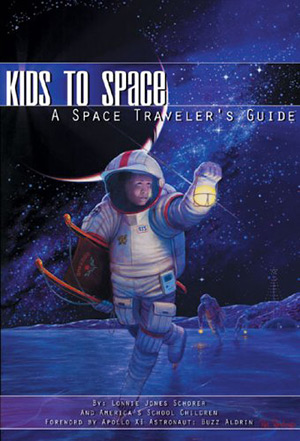Category: Children’s Book
Reviewed by: Robert Z. Pearlman
Title: Kids to Space: A Space Traveler’s Guide
Author: Lonnie Jones Schorer
Reading Level: Ages 9-12
NSS Amazon link for this book
Format: Paperback
Pages: 384
Publisher: Collector’s Guide Publishing (Apogee Books)
Date: 2006
ISBN: 0766013030
What is the recipe for the ultimate space reference book? Take 6,000 students, add in 18,000 of their questions and have 83 experts on hand to answer them. This book is everything you—or your kid—ever wanted to know about space.
Between the years of 1996 and 2001, I created and managed the first Web site that brought together astronauts (both former and active) and the public online. AskAnAstronaut.com (now the property of Imaginova, the parent company that publishes Ad Astra) invited everyone—but mostly kids—to submit their questions for space explorers to answer.
The result after five years was the collection of tens of thousands of questions. Astronauts are busy people though, and only a handful of those—25 or so per flyer—were chosen to answer. Part of my job was to read all the questions submitted through the Web site, pick the best or most popular for reply and then publish the answers. I always desired to find a way to answer every question and wondered what such a reference might look like.
Lonnie Jones Schorer, encouraged by Apollo 11 Moonwalker Buzz Aldrin, has done just that: She not only collected the questions from thousands of students but had nearly 20,000 of their inquiries answered by experts in different fields. Unlike my earlier Web site, Schorer’s goals extended beyond just creating a reference source to also actively engaging today’s youth in the future of human space exploration.
As director of Global Space Travelers, a subsidiary to Aldrin’s self-started nonprofit ShareSpace Foundation, Schorer leads an organization dedicated to supporting individuals who fly to space in any capacity other than as government representatives, e.g. space tourists. They also organize educational outreach activities on the premise that if children are not involved today, there won’t be a foundation from which to build tomorrow.
Kids to Space: A Space Traveler’s Guide began as such a project. Between January and June of 2005, Schorer worked with 99 schools in the United States and Canada to get their students thinking about what they wanted to know about a future space vacation. The kids, ages 3 to 18, were asked to imagine a trip to the Moon or to an orbiting hotel and then submit three questions they wanted to know before departing on the voyage.
The students’ questions—all 18,000 of them—were organized into 94 topics such as how to plan to go, what to do once there and beyond. The most popular, writes Schorer in the book: “How long will it take to get there?”
Schorer sought the assistance of more than 80 experts in various fields to provide the answers. A who’s who of the space world, the book includes the likes of Virgin Galactic CEO Richard Branson (answering questions related to the “administrative logistics” of passenger space travel and “going to space with disabilities”); astronomer Alan Hale (“asteroids, comets and meteors”); former Secretary of Transportation Norman Mineta (“availability” and “economics”); and National Space Society Executive Director George Whitesides (“should we be optimistic?”).
In addition to Aldrin, 15 astronauts also responded, including first space tourist Dennis Tito, educator mission specialist Barbara Morgan and STS-114 crewmember Charles Camarda.
The answers themselves range from single-sentence replies and long paragraphs to full essays. They are also not always definitive; given the imagination of the children and the future nature of the topic, many require a good deal of speculation, like the questions relating to black holes. After all, who knows today if we really can go back in time by plunging into a black hole?
Most of the questions—and their answers—however, are as good a reference for today as they are for years to come. While a potential paying tourist boarding SpaceShipTwo or some other near-future space-bound vehicle might find some of the replies helpful to their planning, so will the student seeking space-related career advice or the average person looking to better understand the space story they heard on the evening news.
Even the very youngest among us can find the book enjoyable. While many of the questions might go over the heads of first graders, the book also includes a storyline that introduces each of the chapters of questions that is written at their level. Parents and teachers might find this useful to respond to their own children’s queries. In addition, over 1,000 children’s illustrations are included with the book, some printed on the pages, with the vast majority on the accompanying CD-ROM (and set to the music of British rock band Hawkwind).
Otherwise, Kids to Space is not the type of book you read cover to cover. It’s instead a handy reference when a question comes to mind. Which is where the Ask An Astronaut Web site approach might have helped: The book begs for a search engine. Even without it though, it’s a wonderful compendium for the who, what, where, when, why and how of our future in space.
© 2007 Robert Z. Pearlman
NSS Featured Review for January 2007
Please use the NSS Amazon Link for all your book and other purchases. It helps NSS and does not cost you a cent! Bookmark this link for ALL your Amazon shopping!



















